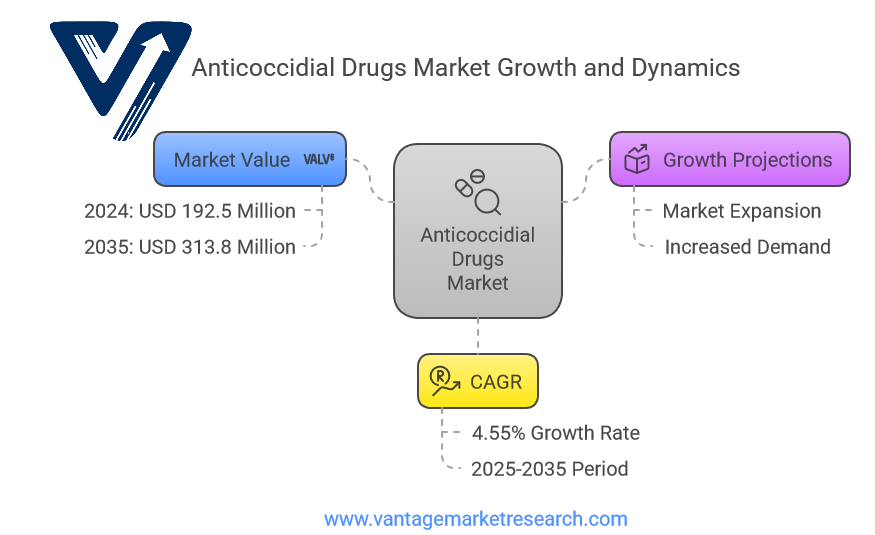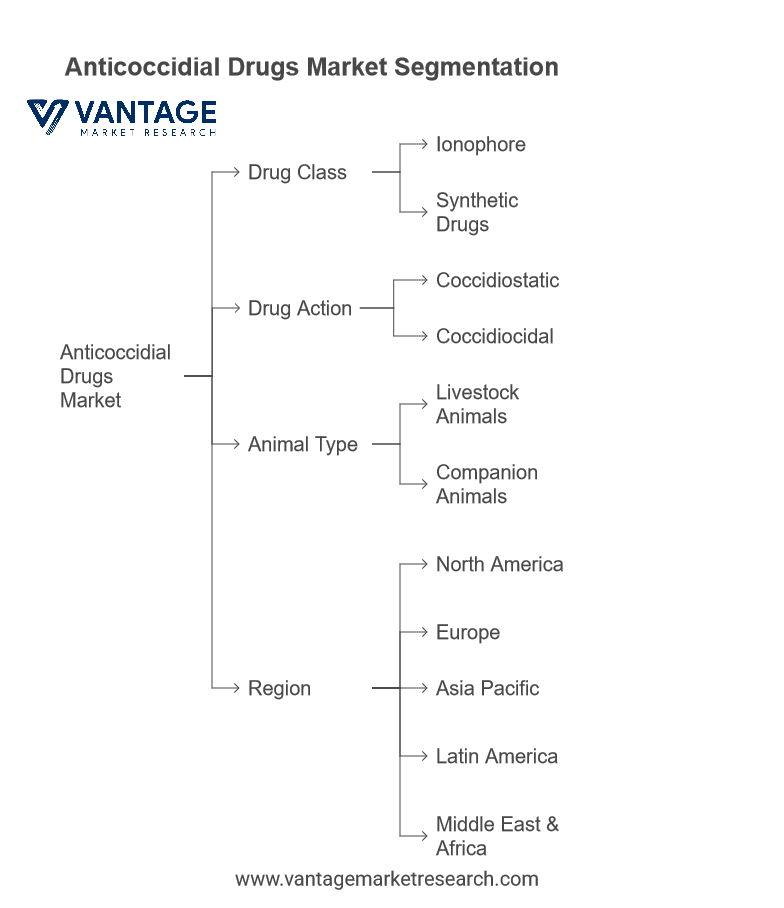
Analysis of The Anticoccidial Drugs Market Size | USD 313.8 Mn & CAGR 4.55% Growth By 2035
Anticoccidial Drugs Market Industry 2025-2035: In-Depth Market Research Report
Vantage Market Research report delves into the Anticoccidial Drugs Market, projecting trends and dynamics from 2025 to 2035. Anticoccidial drugs are essential in veterinary medicine, primarily used to prevent and treat coccidiosis in livestock and companion animals. The report highlights significant market drivers, restraints, and opportunities, alongside a comprehensive analysis of market segments and the competitive landscape. Key players and their strategies are examined, providing insights into the evolving market landscape. The conclusion offers a future outlook, emphasizing growth opportunities and potential challenges in the coming years.
Anticoccidial Drugs Market Size and Forecast
The Anticoccidial Drugs Market plays a crucial role in the veterinary pharmaceutical industry, particularly in the management of coccidiosis, a parasitic disease that affects various animal species. This report aims to provide an in-depth analysis of the market dynamics, segment insights, competitive landscape, and future outlook for the period from 2025 to 2035. Coccidiosis is predominantly caused by protozoan parasites of the genus Eimeria, which can lead to significant economic losses in livestock production due to decreased growth rates, poor feed conversion, and increased mortality. The demand for effective anticoccidial drugs is driven by the growing livestock industry, increasing awareness about animal health, and the rising prevalence of coccidiosis.
The report identifies key trends, including the shift toward more sustainable and effective treatment options, the rise of companion animal ownership, and the increasing regulatory scrutiny on drug residues in animal products. Furthermore, it highlights the importance of innovation in drug formulations and delivery methods, which are expected to shape the market landscape in the coming years.
Download Sample Report PDF (Including Full TOC, Table & Figures) @ https://www.vantagemarketresearch.com/anticoccidial-drugs-market-2423/request-sample
According to analysts at Vantage Market Research, the global Anticoccidial Drugs Market is valued at USD 192.5 Million in 2024 and is projected to reach a value of USD 313.8 Million by 2035 at a CAGR (Compound Annual Growth Rate) of 4.55% between 2025 and 2035.

Market Dynamics
Growth Drivers
- Rising Meat Consumption: Global poultry production, exceeding 130 million metric tons annually, fuels demand for anticoccidial drugs.
- Industrial Livestock Farming: Intensive farming practices heighten disease risk, necessitating prophylactic drug use.
- Disease Prevalence: Coccidiosis costs the poultry industry USD 3 billion yearly, driving drug adoption.
The Anticoccidial Drugs Market is primarily driven by the increasing global demand for animal protein, which necessitates effective disease management strategies in livestock production. The rise in meat consumption, particularly in developing regions, has led to a surge in livestock farming, thereby increasing the demand for anticoccidial drugs. Additionally, advancements in veterinary medicine and the development of novel drug formulations are expected to enhance treatment efficacy and safety, further propelling market growth.
Market Restraints & Challenges
- Antibiotic Resistance: The Overuse of ionophores has led to resistant Eimeria strains, complicating treatment.
- Regulatory Hurdles: Bans on growth promoters in the EU and FDA guidelines in the U.S. limit drug utilization.
Despite the positive growth outlook, the market faces several challenges. The emergence of drug-resistant strains of coccidia poses a significant threat to the effectiveness of existing anticoccidial drugs. Moreover, stringent regulatory frameworks regarding drug approvals and usage in food-producing animals can hinder market expansion. The growing consumer preference for antibiotic-free meat products also presents a challenge, as it may limit the use of certain anticoccidial drugs.
Growth Opportunities & Emerging Trends
- Phytogenic Alternatives: Plant-derived compounds gain traction, with products like oregano oil showing efficacy.
- Vaccine Development: Live-attenuated vaccines, such as HIPRACOX® by HIPRA, reduce reliance on drugs.
Emerging trends, such as the increasing adoption of integrated pest management practices and the development of alternative therapies, including probiotics and herbal remedies, present new growth opportunities in the market. Additionally, the rising trend of pet ownership is expected to drive demand for anticoccidial drugs in companion animals, further diversifying the market landscape.
Regional Breakdown
- North America: Dominates with 35% market share, driven by advanced farming and high meat consumption.
- Asia-Pacific: Anticipated 7% CAGR due to booming poultry sectors in India and China.
The market is segmented geographically into North America, Europe, Asia Pacific, Latin America, and the Middle East and Africa. North America and Europe are expected to dominate the market due to their advanced veterinary healthcare infrastructure and high awareness levels regarding animal health. In contrast, the Asia Pacific region is anticipated to witness significant growth due to the increasing livestock population and rising disposable incomes.
Take Action Now: Secure Your Position in the Global Anticoccidial Drugs Industry Today – Purchase Now.
Segments Insights

The Anticoccidial Drugs Market can be segmented based on drug class, drug action, animal type, and region.
By Drug Class
- Ionophores: These are widely used in poultry and livestock for their effectiveness in preventing coccidiosis. Due to their cost-effectiveness, they hold a 60% market share (2025) but face resistance challenges.
- Synthetic Drugs: These include various chemical compounds that are effective against coccidia and are increasingly being developed to combat resistance. Growing at 6% CAGR, favored for targeted action
By Drug Action
- Coccidiostatic: These drugs inhibit the growth of coccidia, allowing the host's immune system to control the infection. They are preferred for acute outbreaks, capturing a 55% share.
- Coccidiocidal: These drugs kill the coccidia directly, providing a more aggressive treatment option. Used preventively, especially in poultry.
By Animal
- Livestock Animals: This segment includes cattle, sheep, goats, and poultry, which are the primary consumers of anticoccidial drugs. Poultry leads with a 70% share; swine and cattle follow.
- Companion Animals: The increasing trend of pet ownership has led to a growing demand for anticoccidial drugs in this niche segment, which is growing via pet health awareness.
By Region
- North America: Dominated by major players and advanced veterinary practices.
- Europe: High regulatory standards and consumer awareness drive the market. Focus on sustainability drives phytogenic adoption.
- Asia Pacific: Rapid growth due to increasing livestock production and demand for animal protein.
- Latin America: Brazil’s poultry exports bolster drug demand.
For the Anticoccidial Drugs Market Research Report and updates, view the full report now!
Competitive Landscape
The competitive landscape of the Anticoccidial Drugs Market is characterized by the presence of several key players, including Bayer AG, Bioproperties Pty Ltd., Boehringer Ingelheim International GmbH, Ceva Sante Animale, and Zoetis Inc., among others. These companies are focusing on strategic collaborations, mergers, and acquisitions to enhance their market presence and expand their product portfolios.
For instance, Bayer AG has been investing in research and development to innovate new formulations that address the challenges of drug resistance. Similarly, Zoetis Inc. has been expanding its product offerings through acquisitions and partnerships, positioning itself as a leader in the veterinary pharmaceutical market. The competitive strategies employed by these companies are crucial in shaping the future landscape of the Anticoccidial Drugs Market.
The market is consolidated, with the top five players holding a 50% share.
- Bayer AG: Invests in R&D for combination therapies.
- Zoetis Inc.: Expands in Asia-Pacific via partnerships.
- Elanco Animal Health: Leverages digital tools for precision dosing.
Recent mergers, like Vetoquinol’s acquisition of Asian distributors, highlight strategic expansions.
Report Coverage
This report provides a comprehensive analysis of the Anticoccidial Drugs Market, covering key aspects such as market dynamics, segment insights, competitive landscape, and future projections. It includes detailed information on market segmentation, growth drivers, challenges, and emerging trends. The report also highlights case studies and insights from industry leaders, offering a holistic view of the market landscape.
Conclusion and Future Outlook
In conclusion, the Anticoccidial Drugs Market is poised for significant growth from 2025 to 2035, driven by increasing demand for animal protein, advancements in veterinary medicine, and rising awareness of animal health. However, challenges such as drug resistance and regulatory hurdles must be addressed to ensure sustainable market growth. The future outlook suggests a shift toward innovative treatment options and a growing focus on companion animals, presenting new opportunities for market players. As the industry evolves, stakeholders must remain agile and responsive to changing market dynamics to capitalize on emerging trends and maintain a competitive edge.
Frequently Asked Questions
- What are anticoccidial drugs, and why are they crucial in animal health?
- What are the key types of anticoccidial drugs currently dominating the market?
- Which regions are experiencing the highest demand for anticoccidial drugs?
- What are the latest trends driving growth in the anticoccidial drugs market?
- How is the regulatory landscape affecting the development and use of anticoccidial drugs?
- What do manufacturers of anticoccidial drugs face as major challenges?
- What innovations or developments in anticoccidial drugs are expected in the near future?
- How do factors like antibiotic resistance impact the anticoccidial drugs market?
- What role does the increasing demand for poultry and livestock play in the market growth?
- Which companies are leading the anticoccidial drugs market, and what strategies are they employing?
Browse More Health Care Industry News
- The global Animal Healthcare Market is valued at USD 62.89 Billion in 2024 and is projected to reach a value of USD 189.2 Billion by 2035 at a CAGR (Compound Annual Growth Rate) of 10.55% between 2025 and 2035.
- The global Companion Animal Diagnostics Marketis valued at USD 2.6 Billion in 2022 and is projected to reach a value of USD 5.1 Billion by 2030 at a CAGR (Compound Annual Growth Rate) of 9% between 2023 and 2030.
- Global Consumer Genomics market is valued at USD 2.40 Billion in 2022 and is projected to attain a value of USD 10.25 Billion by 2030 at a CAGR of 19.90% during the forecast period, 2022–2028.
- Global Protein Ingredients market is valued at USD 58.47 Billion in 2022 and is projected to attain a market size of USD 95.31 Billion by 2030 at a CAGR of 6.30% during the forecast period, 2022–2028.
- The global Veterinary Diagnostics Market is valued at USD 7.97 Billion in 2024 and is projected to reach a value of USD 24.44 Billion by 2035 at a CAGR (Compound Annual Growth Rate) of 10.75% between 2025 and 2035.

Editor Details
-
Company:
- VMR
-
Name:
- Rahul
- Email:
-
Telephone:
- +12129511369
Related Links
- Website: Anticoccidial Drugs Market
